King Abdullah University of Science & Technology (KAUST) was the host of the ICMERS 2016 conference. Professor Burt Jones, formerly of SCCOOS, opened the conference stating this the second such conference and he hoped that this would be a tradition. This conference goal was to work together, to collaborate on the importance of the Red Sea. The conference attracted 15 countries, 35 organizations and 184 presentations. Research in Red Sea gives us long term benefits to the Kingdom of Saudi Arabia and interested neighbors.
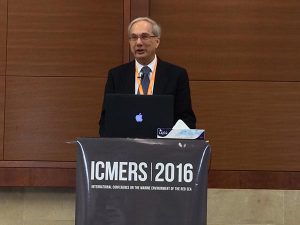
Burt Jones opens the conference. Photo Credit: NOAA/IOOS
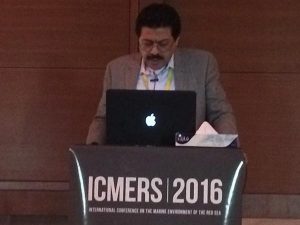
Dr. Omar AbdulHamid speaking to the conference. Photo Credit: NOAA/IOOS
The conference was co-sponsored by KAUST and Saudi Aramco. Dr. Omar AbdulHamid, Manager of Environmental Protection Division, Saudi Aramco, stated they are proud to sponsor the conference and work at KAUST. Acknowledging gaps in physical, chemical and biological processes that are key to sustaining natural resources, he challenged the conference attendees to come up with a vision for a observing and monitoring system for a sustainable Red Sea.
The Beacon at KAUST from the breakout rooms. Photo Credit: NOAA/IOOS
The conference was set up with a morning and afternoon keynotes followed by papers and workshop. Zdenka was pleased to present a keynote on IOOS and the importance of ocean observing to safety, environment and the economy.
Some highlights from the Keynotes include:
Prof Ziad Hamzah Abu-Ghararah, Secretary General, Regional Organization for the Conservation of the Environment of the Red Sea and Gulf of Aden (PERSGA): PERSGA is an intergovernmental organization hosted by the Kingdom of Saudi Arabia. The Red Sea has significant bio-diversity and pristine habitat; economic support, food security, jobs for people in the region. Scientific research is very much needed to fill the gaps in our knowledge of the ecosystem of the Red Sea. We need to strengthen the science to underpin the policy decisions.
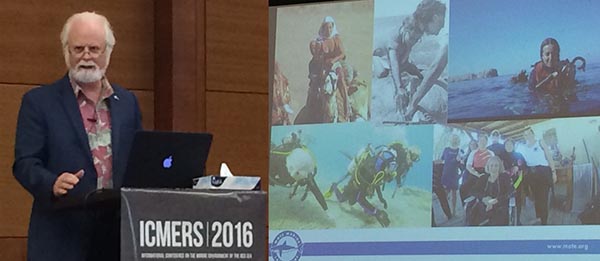
Michael Crosby , MOTE Marine Lab--long time connection to the Red Sea--dates from Jennie's time the inspiration for MOTE. Photo Credit: NOAA/IOOS
Dr. Michael Crosby, President & CEO, MOTE Marine Lab: Grand challenges in our society need to be solved in a collaborative way. Your fish are my fish, your coral spawning is also linked. To bring back Coral Reefs, we need resilient restoration; MOTE has developed techniques to stabilize and restore damaged reefs such as microfragmentation and reskinning to generate 1-2 living corals per year, and they can be exported worldwide.
David Souter, Australian Institute of Marine Science (AIMS): AIMS and KAUST enjoy an international agreement to support monitoring. Monitoring is necessary for situational awareness, is an essential factor in determining impacts of and recovery from a disturbance, qualifies the effectiveness of management, underpins research and innovation and is crucial for education and raising awareness. AIMS has a coral core archive that dates to 1563. Environmental history says first bleaching event occurred in 1982, so it's a recent phenomenon. All of our monitoring is essentially backward looking, we need to reverse that course and use the past to predict the future.
Khalid Zubier, King Abulaziz University, requested the audience to collaborate both nationally and internationally to be efficient with our resources and extend our sciences.
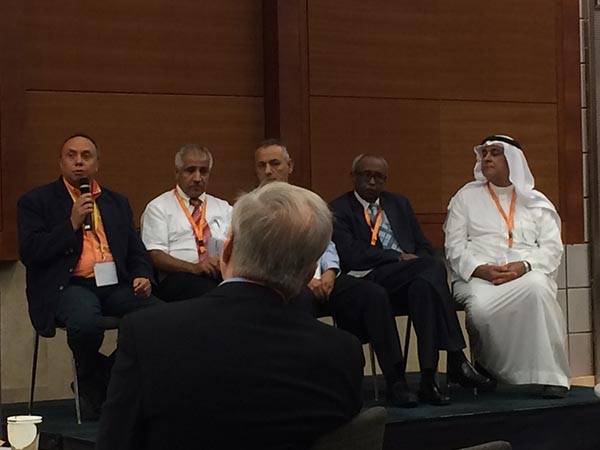
The Regional Panel at the conference. Photo Credit: NOAA/IOOS
A Regional Panel gave country perspectives:
- Prof. Fouad A. Al-Horani, Jordan: The most important ecosystem is the coral reef. We have a small coastal line, 27 km long, and so it must support a concentration of diverse activities such as the port and hotels. Often, there is a conflict of interests between the economy and the environment.
- Dr. El Hag Abu Gabr El Hag, Sudan: The research dates back to 1763. Sudan’s vision is an ecosystem-based approach with nature-based solutions. Sudan's coastal waters contain 2 protected areas a UNESCO world heritage site. We need to collaborate, harmonize curricula, methodology and units of results, and champion joint or common flagship projects for transboundary biodiversity conservation.
- Prof. Adel Ahababy, Yemen: Are you interested to extend your work towards the southern part of the Red Sea and Gulf of Aden? Contact us. Documented human stresses include increased nutrient and sediment loading, direct destruction, coastal habitat modification, contamination, and the very important: the chronic indirect effects of overfishing, including sea cucumber collection.
- Professor Ahmad Mai, Saudi Arabia: Our lives depend on water from the Red Sea. The challenges are funding, building capacity in some scientific disciplines, information & collaborative work.
- Prof. Amr Hamouda, Egypt: Emphasized the need for region wide efforts.
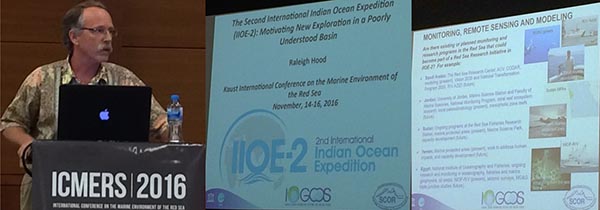
Raleigh Hood, UMCES, addresses the conference. "I will try to motivate the countries of the Red Sea to develop a Red Sea initiative as part of IIOE-2. Photo Credit: NOAA/IOOS
The final keynote speaker, Raleigh Hood, University of Maryland Center for Environmental Science, rallied the participants with a talk to motivate the universities and organizations to come together and be part of the International Indian Ocean Expedition (IIOE-2). Raleigh walked us through a comparison of the themes of IIOE-2 and how they applied to the Red Sea.
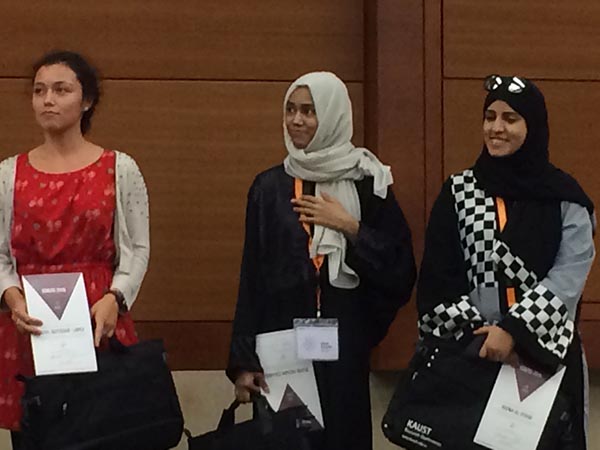
The conference concluded on a positive note with the clean sweep by women scientists for the poster session awards. Photo Credit: NOAA/IOOS
After the conference, a smaller group met to talk about the potential for the Kingdom of Saudi Arabia to come together with other integrated ocean observing systems worldwide. The Coastal Observing Workshop seeks to determine the benefits of an integrated national observational system for Saudi Arabia, clarify the existing in-Kingdom capabilities regarding a national observation system, and determine what role may be envisioned for ministries, industry and universities of Saudi Arabia. Zdenka presented on the imperatives of a national system like IOOS. The main message to the group was that IOOS works because of the people and the desire to work together, that they needed to form a structure but foremost this was something they needed to see the benefit of because the challenges would always be there. A great summary of the discussion and quote of the day came from Ibrahim Hoteit (KAUST): “Without data it is like driving without headlights, without models is like riding in a car without GPS."
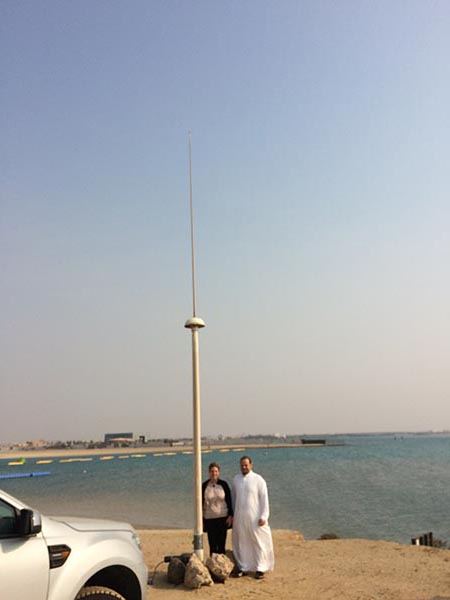
Zdenka & Khaled Asfahani (KAUST) at HF Radar site along the Red Sea. Photo Credit: NOAA/IOOS
As thought-provoking as the week had been, I could not leave without seeing the high frequency radar site on the Red Sea and the plans for additional deployments. It's a great step in building a coastal observing system to provide critical environmental data to the kingdom and the world.
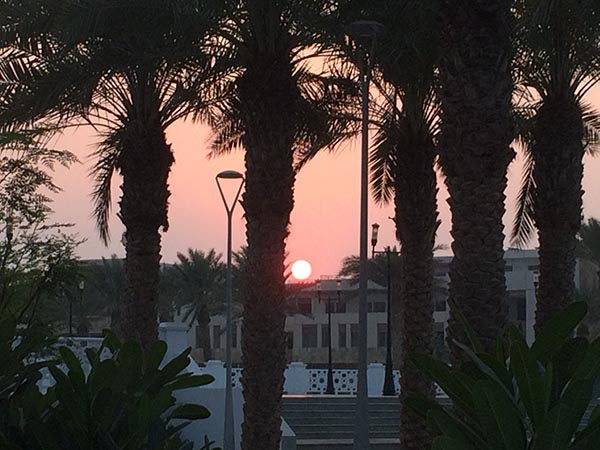
Sun setting on KAUST. Photo Credit: NOAA/IOOS
As the sun set on my last day at KAUST, I hope this is the beginning of an integrated ocean observing system for the Kingdom of Saudi Arabia.

Art around KAUST. Clockwise: The Beacon, a naturally-cooled lighthouse and gathering place at the harbor entrance to KAUST; The King Abdullah Monument, the Murano glass centerpiece of King Abdullah Monument Park on the KAUST campus; and ‘Mathematical Spaces’, representing Applied Mathematics and Computational Sciences and ‘Colorful Pyramids’, representing the Material Sciences and Engineering, sculptures inside the Revival of Islamic Sciences Museum. Photo Credit: NOAA/IOOS
 Official websites use .gov
Official websites use .gov Secure .gov websites use HTTPS
Secure .gov websites use HTTPS
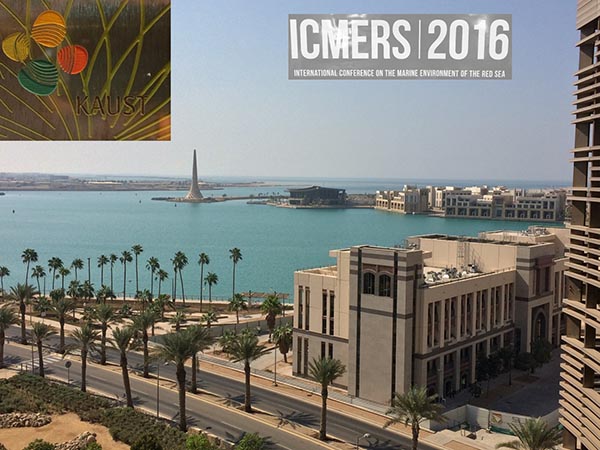
.jpg)